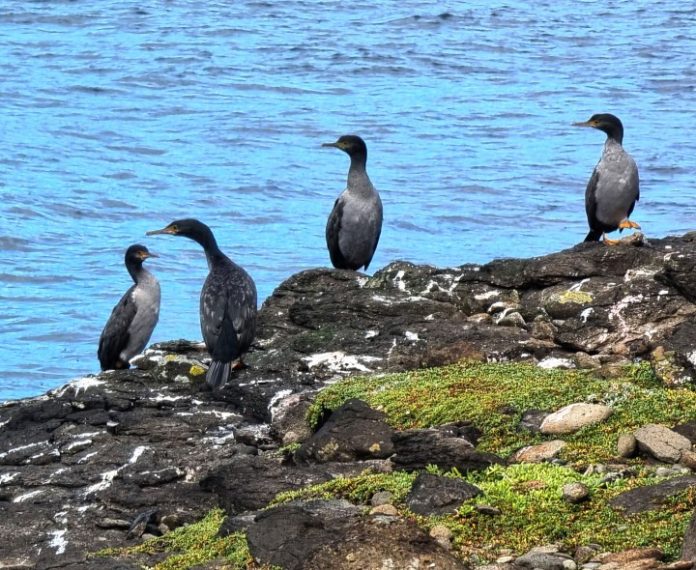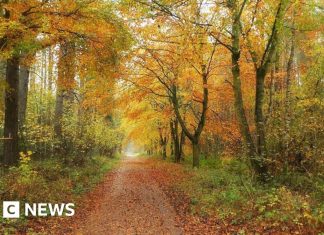Today we have a contribution of miscellaneous flora and fauna from reader David Riddell, a Kiwi. His descriptions and IDs are indented, and you can enlarge the photos by clicking on them.
Recently I sent in some pictures of seabirds to be posted here, several of them taken on a trip to New Zealand’s Chatham Islands. I thought I’d add a few more images from that trip, starting with this group of Pitt Island shags (Phalacrocorax featherstoni). These are endemic to the Chathams – one of two species found only there, and one of 13 New Zealand cormorant species, which are generally all referred to as shags in this country. There are fewer than 500 pairs of both Chatham species, and their numbers appear to be declining. Unfortunately these are not in breeding plumage, when they look a lot more handsome:
Shore plovers (Charadrius novaeseelandiae) were wiped off the New Zealand mainland by exotic mammalian predators by the 1870s, and for more than a century existed only on Rangatira Island, which lies just off Pitt Island in the Chathams. Small populations have now been re-established on a couple of predator-free islands off the New Zealand mainland, as well as another island in the Chathams group, but the global population is still below 200. Intensive predator control on Pitt (where a few feral cats persist) has recently allowed the odd pair to breed there, which is where we saw this one, along with a recently fledged juvenile:
In the 1970s there were only about 50 Chatham Island oystercatchers (Haematopus chathamensis). With management there are now over 300, but they are still the world’s rarest oystercatcher. These were on Pitt, very close to the shore plover above:
Back on main Chatham, the parea, or Chatham Island pigeon (Hemiphaga chathamensis) has benefited from predator control which has seen its numbers rise from a low of about 45 birds in 1989 to an estimated population of more than 600. They are larger and greyer than the New Zealand pigeon, or kereru (Hemiphaga novaeseelandiae), with a stouter, more brightly coloured bill:
For comparison, this is a kereru, which are reasonably common and widespread on the New Zealand mainland:
Not the most photogenic of creatures perhaps, but this is a chick of one of the world’s rarest seabirds, the Chatham Island taiko, or Magenta petrel (Pterodroma magentae). First described from a bird collected in 1867 by the Italian research vessel Magenta it was tentatively identified in the 20th century with the taiko, which was believed to be extinct. The identity was confirmed in 1978 when ornithologist David Crockett found live birds in the southwest of Chatham Island. About 20 breeding burrows are currently known, many with observation hatches like this one, and mostly within a predator-fenced reserve. The total population is probably fewer than 200, though slowly increasing:
The Chathams only have one lizard species, the Chatham Island skink (Oligosoma nigriplantare). It’s extinct on the main island, but is still common on Pitt and the outlying islands:
The Chatham Island red admiral (Vanessa gonerilla ida) is an endemic subspecies which is notably common throughout the islands:
The Chatham Islands’ plants also show a high degree of endemism. This is a rautini (Brachyglottis huntii), sometimes called the Chatham Island Christmas tree as it flowers conspicuously in the height of the southern hemisphere summer. This one is a bit past its best in March:
The Chatham Island geranium (Geranium traversii) is a pretty little flower sometimes grown in rock gardens on the mainland:
There was an attempt to establish a business farming emus (Dromaius novaehollandiae) in New Zealand late last century, but it never became a significant industry, though a few of the big birds remain here and there, mostly in small flocks (herds?) on lifestyle blocks. They’ve gone feral in a few areas, although they are still not officially recognised as part of the local avifauna. Chatham Island now has dozens roaming wild through central parts of the island; there’s talk of trying to eradicate them, but for now they’re an unexpected addition to the landscape:
Much of Chatham Island is occupied by a huge brackish lagoon, along the shores of which, at a spot called Blind Jim’s Creek, you can find fossilised shark teeth. These are between 30 and 60 million years old; most are mako (Isurus oxyrhynchus, or perhaps an ancestor), but other species, including Otodus megalodon, also occur. In the background of the picture below there are also some fossilised urchin spines, which are present along with the teeth. Three of us found this collection in about an hour of searching:
It’s a bit hard to make out, but this is a dendroglyph, markings carved into the bark of a kopi (Corynocarpus laevigatus) tree by the Moriori, who were the original inhabitants of the Chathams. They had one of the world’s only true pacifist societies, and when Maori from New Zealand invaded in 1835 they put up no resistance. Consequently they were massacred, many of them were eaten (Maori were cannibals), and the rest enslaved. Within a century the last full-blooded Moriori was dead, though a few people today still claim Moriori ancestry, descended from slaves and their Maori masters. The dendroglyphs are now at least 190 years old, and very few are left. We found this one, not signposted and not visible from the track, entirely by chance, in a patch of forest where their presence was not known, or at least not publicised:





















